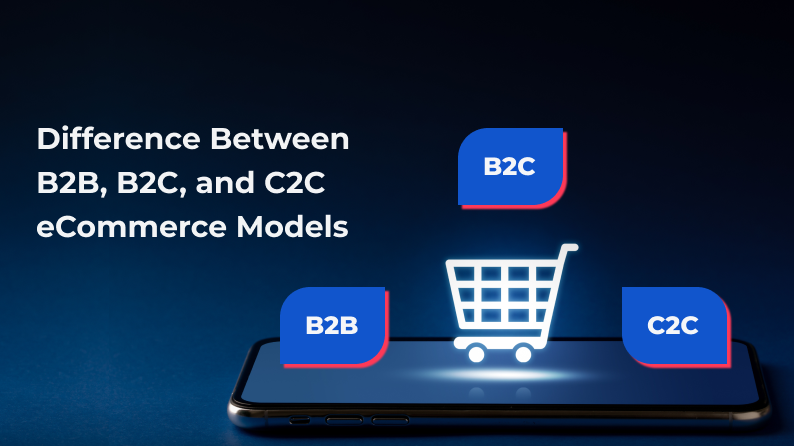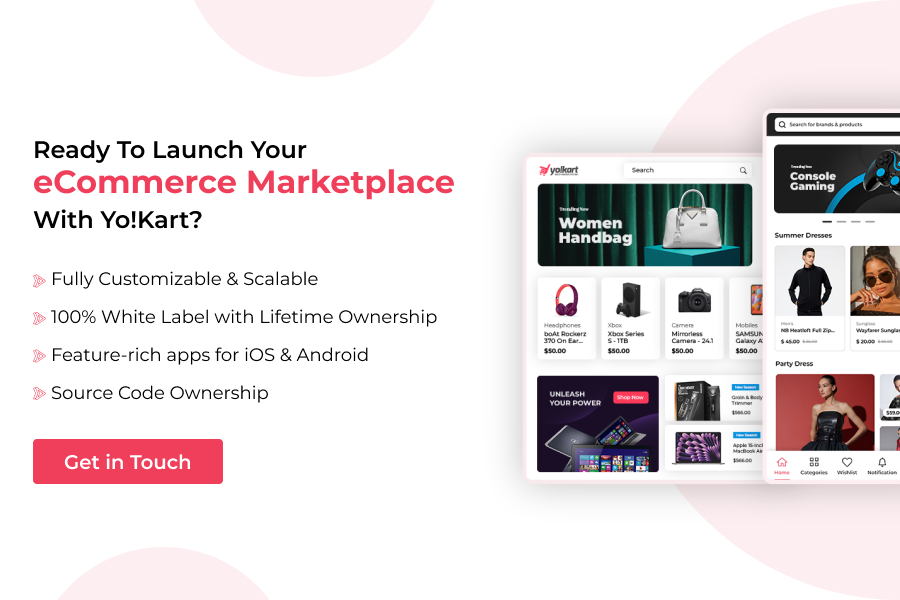Last Updated: 20th May, 2025
In today’s digitally driven economy, the boundaries between buyers and sellers are more dynamic than ever. eCommerce marketplaces have transformed the global retail landscape, offering businesses and consumers new ways to connect and transact.
According to Statista, the global eCommerce market is expected to reach an impressive $5.89 trillion by 2029 at a CAGR of 8.02% for the forecast period 2025-2029—presenting a lucrative business opportunity. However, as businesses navigate their digital transformation journeys, selecting the right eCommerce marketplace model becomes a strategic decision that can define market reach, customer engagement, and long-term scalability.
Whether you’re building a digital storefront, expanding into new verticals, or streamlining supply chain interactions, understanding the fundamental differences between B2B, B2C, and C2C eCommerce marketplace models is essential. Therefore, in this write-up, we cover eCommerce business models, B2B, B2C, and C2C, and how they differ from each other in meeting business expectations.
Table of Contents
- What is an eCommerce Marketplace?
- Types of eCommerce Marketplace Models
- B2B, B2C, and C2C: Understanding the Business Model
- Key Features of a B2B, B2C, and C2C eCommerce Marketplace
- Understanding the Core Differences Between B2B, B2C, and C2C eCommerce Marketplace Models
- Popular Platforms that Combine B2B, B2C, and C2C eCommerce Marketplace Models
- Yo!Kart: Robust eCommerce Marketplace Software
- Conclusion
- FAQs
What is an eCommerce Marketplace?
An eCommerce marketplace is an online platform where multiple third-party sellers can list and sell their products or services to customers. Unlike traditional online stores that sell products from a single brand or retailer, an eCommerce marketplace allows third-party vendors to list and sell their goods or services directly to consumers.
This model benefits both sellers and buyers. Sellers gain access to a broader audience without the need to build and maintain their own eCommerce websites, while buyers enjoy a wide variety of products, competitive pricing, and the convenience of shopping from multiple vendors in one place.
Types of eCommerce Marketplace Models
eCommerce marketplaces aren’t one-size-fits-all—they vary based on who the buyers and sellers are. Understanding these eCommerce marketplace models is essential for choosing the right approach to reach your target audience and meet your business goals. The three main types are B2B, B2C, and C2C, each serving a distinct purpose in the digital commerce ecosystem.
Here’s a detailed overview:
1. B2B (Business-to-Business) eCommerce Marketplaces: In a B2B marketplace, transactions occur between businesses, allowing suppliers, manufacturers, wholesalers, or service providers to sell products or services to other businesses. These marketplaces often involve bulk orders, longer sales cycles, and custom pricing.
2. B2C (Business-to-Consumer) eCommerce Marketplaces: B2C marketplaces connect businesses directly with individual consumers. These are the most common types of eCommerce platforms, where businesses list products for end-users to browse, purchase, and receive at home.
3. C2C (Consumer-to-Consumer) eCommerce Marketplaces: In a C2C eCommerce marketplace model, individuals sell products or services directly to other individuals, often through a third-party platform that facilitates transactions and ensures trust. These platforms thrive on peer-to-peer selling and user-generated listings.
B2B, B2C, and C2C: Understanding the Business Model
When entering the eCommerce space, it’s essential to understand the core differences between B2B, B2C, and C2C eCommerce marketplace models to determine the best fit for your specific needs and goals. Each serves a distinct purpose, caters to a specific audience, and operates with unique business dynamics.
Here are the eCommerce marketplace models explained thoroughly:
1. B2B eCommerce Marketplace Model
A B2B (Business-to-Business) eCommerce marketplace is an online platform where businesses can sell products or services directly to other businesses, rather than individual consumers. Unlike traditional single-vendor B2B eCommerce platforms, a B2B marketplace features multiple sellers offering a wide range of goods or services to other businesses under one roof.
B2B eCommerce marketplaces are designed to handle high-volume transactions, bulk orders, and longer-term contracts. This model typically includes interactions between manufacturers, wholesalers, distributors, and retailers.
Popular B2B eCommerce Marketplaces
- Amazon Business: A popular B2B eCommerce marketplace launched in 2015 by Amazon. It provides the opportunity for businesses of all sizes to trade in bulk, as its name suggests. The platform boasts an intuitive interface like Amazon.com that makes buyers on the platform feel familiar. The combined value of gross merchandise volume (GMV) of Amazon Business is expected to surge to $83.1 billion in 2025.
- Alibaba: Founded in 1999 by a group of 18 people, including Jack Ma and 17 friends, Alibaba is now one of the world’s leading B2B marketplaces that connects manufacturers, suppliers, and wholesalers on a digital platform to initiate B2B transactions. Moreover, the platform’s estimated revenue is approximately $136.23 billion, with 105.33 million estimated total visits till May 2025.
- eWorldTrade: eWorldTrade, launched in 2016, is a leading B2B marketplace that connects millions of buyers with suppliers across the world. Currently, the platform has over 7,000,000 registered users. eWorldtrade provides a safe, fast, and reliable buying opportunity for businesses.
Suggested Read: Explore the post on Building a B2B Online Marketplace
Build a B2B marketplace with result-oriented B2B features
2. B2C eCommerce Marketplace Model
The Business-to-Consumer (B2C) eCommerce marketplace model involves businesses selling products or services directly to individual customers, eliminating the need for intermediaries. This marketplace model empowers businesses to reach a broader audience with the help of a digital platform that serves as a bridge between businesses and end-users, offering a streamlined and user-friendly buying experience.
One of the defining features of B2C marketplaces is the relatively short customer journey. B2C digital marketplaces help close the gap between online and offline shopping by offering convenience, speed, and accessibility. They provide personalized shopping experiences using data-driven recommendations, targeted promotions, and customer-centric interfaces that make browsing and purchasing intuitive.
Popular B2C eCommerce Marketplaces
- Amazon: Amazon is arguably the most recognized name in the global eCommerce landscape. Originally launched in 1994 by Jeff Bezos, it has since evolved into a comprehensive digital eCommerce marketplace offering an extensive range of products and services—from electronics and apparel to cloud computing and streaming. In addition, the platform generated a staggering $650.313B in revenue till March 2025 alone, solidifying its position as a dominant force in the eCommerce industry.
- Walmart: Walmart, originally established as Wal-Mart stores in 1962 by Sam Walton, has grown into one of the world’s largest and most influential retail giants. Over the decades, it has successfully transformed into a leading omnichannel marketplace. Known for its commitment to offering everyday low prices, Walmart stands out with its extensive product range. This vast assortment, combined with a strong logistics network and a focus on customer convenience, gives Walmart a competitive edge in both brick-and-mortar and online retail.
- eBay: eBay is a globally recognized online marketplace that connects millions of buyers and sellers across a wide range of product categories. Originally launched in 1995 as an online auction platform, eBay has since evolved into a dynamic eCommerce ecosystem that supports both auction-style listings and fixed-price sales. The platform allows users to list and sell both physical and digital products through shared storefronts, making it easy for sellers to reach a broad and diverse audience.
Explore An In-depth Guide to Build a B2B2C Marketplace
3. C2C eCommerce Marketplace Model
The C2C (Consumer-to-Consumer) business model facilitates direct transactions between individual consumers. This model is typically enabled by a third-party platform that acts as a digital marketplace, allowing users to list their products or services for sale. Other users can then browse these listings and choose to purchase items based on their needs or interests.
C2C platforms often specialize in secondhand, vintage, or otherwise unique items that may not be easily found in traditional retail stores. The primary advantage of the C2C model is its ability to connect individuals with minimal overhead costs. It empowers consumers to become entrepreneurs and fosters a sense of community among users.
Popular C2C eCommerce Marketplaces
- eBay: Launched in 1995 by Pierre Omidyar, eBay is a pioneer in the C2C eCommerce marketplace model. Originally known for online auctions, eBay has evolved into a global platform that supports both fixed-price and auction-style listings across a wide range of product categories. The platform has generated a revenue of $10.312 billion by 2025 (Q1), highlighting its enduring presence in the global eCommerce space. eBay’s scalable model and trusted payment system continue to make it a go-to marketplace for secondhand goods, collectibles, electronics, fashion, and more.
- OLX: OLX (OnLine eXchange), founded in 2006 by Fabrice Grinda and Alec Oxenford, is a prominent C2C eCommerce platform operating in over 45 countries. Unlike traditional marketplaces, OLX enables users to list items locally, often facilitating offline transactions. This makes it especially popular for secondhand goods such as electronics, furniture, vehicles, and real estate. The platform attracts over 33 million monthly active users, helping millions of individuals buy, sell, or trade products and services without the need for intermediaries.
- Etsy: Founded in 2005 by Robert Kalin, Chris Maguire, and Haim Schoppik, Etsy has grown into one of the most popular C2C (consumer-to-consumer) eCommerce marketplaces in the world. The founders identified a gap in the market for handmade and vintage items, leading to the creation of a platform tailored for artisans and independent sellers. As of 2025, Etsy hosts about 95.5 million active buyers and supports a thriving community of 8.13 million active sellers.
Suggested Read: How to build a C2C marketplace?
Key Features of a B2B, B2C, and C2C eCommerce Marketplace
No matter the model—B2B (Business-to-Business), B2C (Business-to-Consumer), or C2C (Consumer-to-Consumer)—successful eCommerce marketplaces share several core features that ensure functionality, security, scalability, and user satisfaction. These features form the foundation of a seamless digital shopping experience.
Here are the core features that are common in all eCommerce marketplace models:
1. Intuitive User Interface: A clean, responsive, and easy-to-navigate UI ensures that users—buyers and sellers alike—can interact with the platform effortlessly across all devices.
2. Effortless Login & Registration: Enable quick sign-up and login options, including social media or email integration, to improve user onboarding and retention.
3. Advanced Search & Filtering Module: Equip smart search filters with category, price, rating, and location in order to allow users to find products quickly and easily.
4. Live Order Tracking: Real-time shipping updates and integration with logistics providers improve transparency and customer satisfaction.
5. Easy Checkout Process: A smooth, multi-step or one-page checkout with multiple payment options reduces cart abandonment and helps customers buy products effortlessly.
6. Individual Seller Storefronts: Each seller should have a customizable storefront or profile to showcase their products, reviews, and branding.
7. Comprehensive Admin Dashboard: A powerful backend system that enables platform owners to manage users, transactions, listings, payments, and settings efficiently.
8. Robust Reports & Analytics Tools: Data-driven insights help sellers and admins monitor sales, customer behavior, and marketplace performance for better decision-making.
9. Effective Marketing Tools: Integrate effective marketing tools such as email campaigns, discount codes, upselling/cross-selling features, and loyalty programs to enhance customer engagement and conversions.
10. Security Compliance: Secure payment gateways, encryption, and compliance with data protection laws (e.g., GDPR, PCI-DSS) are essential for trust and safety.
Now that we’ve discussed the common features of eCommerce marketplaces, let us take a look at the essential features of a B2B, B2C, and C2C eCommerce marketplace:
| B2B eCommerce Marketplace | B2C eCommerce Marketplace | C2C eCommerce Marketplace |
| Bulk Orders | Product Catalog | Simplified Product Listing |
| Tiered Pricing | Shopping Cart & Checkout | In-App Chat |
| Request-for-Quote (RFQ) Module | Personalized Product Recommendations | Local Listings and Geo-Based Search |
| Part Payment Option | Wishlist & Favorites Feature | Safe Payment Options |
| Hide Product Prices | Mobile App Integration | Dispute Resolution System |
| Minimum Order Quantity | Inventory Management | Effective Search Filters |
| Custom Invoicing | Reviews and Ratings | Push Notifications |
| Tax Management | Loyalty Points & Rewards Systems | Product Authentication Services |
Understanding the Core Differences Between B2B, B2C, and C2C eCommerce Marketplace Models
Understanding the core differences between B2B, B2C, and C2C eCommerce marketplace models is essential for businesses planning to launch or scale an eCommerce marketplace. Each model caters to a different audience, with unique operational requirements, customer expectations, and monetization strategies.
Here are the core distinctions explained:
| Parameter | B2B | B2C | C2C |
| Target Audience | Businesses selling to other businesses | Businesses selling to individual consumers | Individuals selling to other individuals |
| Market Size | Smaller in terms of buyers, but larger in value | Larger in buyers, moderate in value | Large but fragmented |
| Transaction Volume | High-value, bulk orders | Medium to low, single-item orders | Typically low-value, second-hand items |
| Sales Cycle | Lengthy and detailed | Quick and simple | Quick, informal |
| Focus | Efficiency, ROI, and long-term value | Convenience, price, & product/service appeal | Trust, product condition, price |
| Business Approach | Relationship-driven, consultative | Marketing-driven, transactional | Peer-to-peer, platform-facilitated |
| Complexity | High (negotiations, custom pricing, contracts) | Low to moderate | Low |
| Quantity | Large orders or recurring shipments | Single or small quantity purchases | Typically single units |
| Relationship Horizon | Long-term partnerships | One-time or short-term | One-time or casual |
| Decision Maker | Multiple stakeholders (procurement, finance, etc.) | Individual buyer | Individual buyer |
| Buying Decision | Logic-driven (cost-benefit, ROI, specs) | Emotion and need-driven | Need and trust-driven |
| Marketing Strategy | Relationship-driven, niche targeting | Mass marketing, brand building | Peer reviews, trust-based interactions |
| User Experience Focus | Functionality, efficiency, B2B features | UX/UI design, convenience, speed | Simplicity, peer interaction |
Popular Platforms that Combine B2B, B2C, and C2C eCommerce Marketplace Models
Some of the most successful and scalable eCommerce marketplaces today don’t confine themselves to a single business model. Instead, they blend B2B, B2C, and C2C functionalities to serve a broader market and enhance revenue opportunities.
Here are some of the most notable platforms that have successfully integrated multiple eCommerce marketplace models:
1. Amazon
Amazon is the quintessential example of a hybrid eCommerce marketplace. Although it started primarily as a B2C platform, but now includes:
- B2B: With Amazon Business, companies can purchase bulk products and access business-specific pricing.
- C2C: Individuals can list used or handcrafted products for sale, similar to a peer-to-peer model.
- B2C: Brands and retailers sell directly to consumers through Amazon’s global storefront.
This diversification has helped Amazon capture every segment of the market, from individual buyers to enterprise clients, greatly boosting its revenue and user base.
2. Alibaba
Alibaba is predominantly known for its B2B operations, but also integrates B2C and C2C under different sub-brands:
- B2B: The core Alibaba.com platform connects manufacturers and wholesalers with businesses worldwide.
- B2C: AliExpress caters to individual consumers shopping for products, typically in smaller quantities.
- C2C: Taobao, a subsidiary, allows consumers to sell items directly to other consumers, similar to eBay.
This layered model has allowed Alibaba to build one of the most extensive eCommerce ecosystems in the world, benefiting from both scale and diversity.
Launch a marketplace with support for multiple revenue channels
3. Epson America
Epson America exemplifies a hybrid eCommerce model by integrating B2B and B2C functionalities within a unified digital platform. Here’s how:
- B2B: Epson provides business solutions, including printers, projectors, and point-of-sale systems, catering to various industries.
- B2C: Consumers can purchase products directly from Epson’s online store, which offers a range of electronics and accessories.
- C2C: While Epson does not operate a traditional C2C marketplace, it supports small businesses and entrepreneurs by offering tools like ColorWorks label printers, enabling them to create and sell customized products.
By combining B2B, B2C, and elements supporting C2C interactions, these platforms create versatile ecosystems that attract diverse sellers and buyers. This strategic flexibility allows them to maximize engagement, increase transaction volume, and remain resilient in a highly competitive eCommerce landscape.
Yo!Kart: Robust eCommerce Marketplace Software
When it comes to building a scalable and customizable multi-vendor eCommerce marketplace, Yo!Kart stands out as a powerful solution. It is a multi-vendor eCommerce marketplace software with all the out-of-the-box functionalities to deliver future-ready platforms.
Designed specifically to support a range of business models—including B2B, B2C, and C2C—Yo!Kart provides businesses with the flexibility and functionality needed to launch and grow a successful online marketplace. It provides multi-channel support to diversify eCommerce marketplace revenue streams through commissions, subscription packages, paid ads, PPC, and more.
In addition to Yo!Kart, there is another specialized solution known as Yo!Kart B2B, exclusively designed to power a marketplace for B2B eCommerce. It includes specific B2B functionalities like an in-built RFQ module, support for bundled and exclusive services and products, minimum order quantity, bulk price discounts, direct messaging, and more.
Here’s why you should choose Yo!Kart:
- Supports all major eCommerce models, including B2B, B2C, and C2C.
- Offers lifetime ownership with a one-time license fee.
- 100% white label to match your brand and business needs.
- Built-in features reduce the need for third-party integrations.
- Scalable architecture ensures growth without performance issues.
- Offers native mobile apps for both Android & iOS.
- SEO-friendly structure helps improve your online visibility.
- Secure payment gateways and multi-currency support.
- Global-ready with multi-lingual capabilities.
- Dedicated 1 year of free technical support.
Apart from this, Yo!Kart has earned the trust of entrepreneurs, startups, and enterprises across the globe. Here’s a look at some types of clients who have leveraged Yo!Kart to build thriving online marketplaces across different eCommerce marketplace models:
1. UNI Diamonds – Online B2B Diamond Trading Marketplace
2. Bozinga – American online B2B wholesale marketplace
3. Voyij – Travel Activities & Shopping Platform
4. Regake – Global Digital Products Marketplace for Video Games
5. OGI- One-Stop-Shop to Locate Specific Machinery Parts
Schedule a Personalized Demo to Know More About Yo!Kart
Conclusion
Modern eCommerce marketplaces must be purpose-driven to optimize workflows for all participants, with a strong focus on enhancing the customer’s online shopping journey—from browsing and purchasing to returns and exchanges.
Choosing the right business model from the outset, along with the essential features to support it, is key to achieving successful outcomes. Understanding the distinctions between B2B, B2C, and C2C eCommerce marketplace models—and what each offers for different business needs—enables more informed and confident decision-making to build any eCommerce marketplace.
FAQs
Q 1. What are the primary differences between B2B and B2C marketplaces?
Ans. Below are the main differences between B2B and B2C marketplaces:
- Target audience: The B2B marketplace targets businesses, whereas B2C marketplaces target individuals.
- Order Quantity: B2B marketplaces deal in large volume orders. However, in B2C individual orders of one or two products mean small in quantity for personal use.
- Product Offerings: B2B marketplaces offer tailored products, but in B2C, standardised products are offered.
- Customization Flexibility: B2B marketplaces provide complete flexibility for customization but in B2C there a less flexibility to customize products or no customization available.
Q 2. What are the different types of eCommerce marketplaces?
Ans. There are four types of eCommerce marketplaces:
- Business-to-Business (B2B) Marketplaces: facilitate transactions between businesses.
- Business-to-Consumer (B2C) Marketplaces: enable businesses to connect with a wide variety of audiences on a digital platform.
- Consumer-to-Consumer (C2C) Marketplaces: connect individuals with other individuals to buy or sell products.
Q 3. Which is the most common type of eCommerce marketplace?
Ans. B2C (Business-to-Customer) is the most common type of eCommerce platform.
Q 4. How to build and launch an eCommerce marketplace?
Ans. There are two primary ways to build and launch an eCommerce marketplace platform:
- Develop a Platform from Scratch: It is a lengthy process that requires time, resources, expert developers and even more. This process can be very costly and time-consuming.
- Choose a SaaS-based solution: You can launch your online store by choosing software-as-a-service. Although this approach offers cost-effectiveness and rapid deployment, there are a few disadvantages as well, including a lack of control, limited customization, security vulnerability, limitations with integration, and more.
- Self-hosted Readymade Solution: These solutions are ready-to-use means you can launch your marketplace in less possible time. These solutions offer complete control over your platform and integrate all essential features & business APIs to build a fully functional app with rapid deployment.
Yo!Kart is a self-hosted eCommerce marketplace software that allows entrepreneurs or business owners to launch their own eCommerce marketplace in less possible time. It is also a fully customizable and scalable solution that gives the flexibility to customize and scale the platform according to the requirements.
Q 5. Is there any software that supports all eCommerce marketplace models to build any eCommerce marketplace?
Ans. Yes, Yo!Kart is a versatile eCommerce marketplace software that supports all major marketplace models, including B2B, B2C, C2C, and multi-vendor setups, making it ideal for building any type of eCommerce marketplace across several niches.




